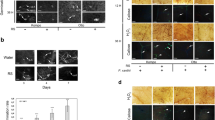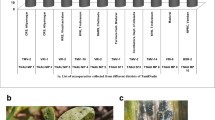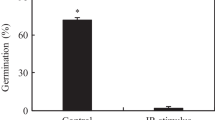Abstract
Main Conclusion
Systemic acquired resistance elicitors, BTH and BABA, reduce rust penetration in pea through phytoalexins pathway but differing in their mode of action.
It has been previously shown that rust (Uromyces pisi) infection can be reduced in pea (Pisum sativum) by exogenous applications of systemic acquired resistance elicitors such as BTH and BABA. This protection is known to be related with the induction of the phenolic pathway but the particular metabolites involved have not been determined yet. In this work, we tackled the changes induced in phytoalexin content by BTH and BABA treatments in the context of the resistance responses to pea rust. Detailed analysis through high-performance liquid chromatography (HPLC) showed qualitative and quantitative differences in the content, as well as in the distribution of phytoalexins. Thus, following BTH treatment, we observed an increase in scopoletin, pisatin and medicarpin contents in all, excreted, soluble and cell wall-bound fraction. This suggests fungal growth impairment by both direct toxic effect as well as plant cell wall reinforcement. The response mediated by BTH was genotype-dependent, since coumarin accumulation was observed only in the resistant genotype whereas treatment by BABA primed phytoalexin accumulation in both genotypes equally. Exogenous application to the leaves of scopoletin, medicarpin and pisatin lead to a reduction of the different fungal growth stages, confirming a role for these phytoalexins in BTH- and BABA-induced resistance against U. pisi hampering pre- and postpenetration fungal stages.






Similar content being viewed by others
Abbreviations
- BABA:
-
(D,L)-3-amino-n-butanoic ((D,L)-β-aminobutyric) acid
- BTH:
-
Benzo[1,2,3]thiadiazole-7-carbothionic acid-S-methyl ester (Bion®)
- SAR:
-
Systemic acquired resistance
References
Amzalek E, Cohen Y (2007) Comparative efficacy of systemic acquired resistance-inducing compounds against rust infection in sunflower plants. Phytopathology 97:179–186
Arfaoui A, El Hadrami A, Mabrouk Y, Sifi B, Boudabous A, El Hadrami I, Daayf F, Chérif M (2007) Treatment of chickpea with Rhizobium isolates enhances the expression of phenylpropanoid defense-related genes in response to infection by Fusarium oxysporum f. sp. ciceris. Plant Physiol Bioch 45:470–479
Baldoni E, Mattana M, Locatelli F, Consonni R, Cagliani LR, Picchi V, Abbruscato P, Genga A (2013) Analysis of transcript and metabolite levels in Italian rice (Oryza sativa L.) cultivars subjected to osmotic stress or benzothiadiazole treatment. Plant Physiol Bioch 70:492–503
Barilli E, Serrano A, Sillero JC, Rubiales D (2009a) Differential response of pea (Pisum sativum) to rusts incited by Uromyces viciae-fabae and U. pisi. Crop Prot 28:980–986
Barilli E, Sillero JC, Moral A, Rubiales D (2009b) Characterization of resistance response of pea (Pisum spp.) against rust (Uromyces pisi Pers.) Wint. Plant Breed 128:665–670
Barilli E, Sillero JC, Rubiales D (2010a) Induction of systemic acquired resistance in pea against rust (Uromyces pisi) by exogenous application of biotic and abiotic inducers. J Phytopathol 158:30–34
Barilli E, Prats E, Rubiales D (2010b) Benzothiadiazole and BABA improve resistance to Uromyces pisi (Pers.) Wint. in Pisum sativum L. with an enhancement of enzymatic activities and total phenolic content. Eur J Plant Pathol 128:483–493
Barilli E, Rubiales D, Castillejo MA (2012) Comparative proteomic analysis of BTH and BABA-induced resistance in pea (Pisum sativum) toward infection with pea rust (Uromyces pisi). J Proteomics 75:5189–5205
Castillejo MA, Maldonado AM, Dumas-Gaudot E, Fernández-Aparicio M, Susín R, Rubiales D (2009) Differential expression proteomics to investigate responses and resistance to Orobanche crenata in Medicago truncatula. BMC Genom 10:1–17
Choi WB, Kang SH, Lee YW, Lee YH (1998) Cyclic AMP restores appressorium formation inhibited by polyamines in Magnaporthe grisea. Phytopathology 88:58–62
Cruickshank IAM (1962) Studies on phytoalexins IV. The antimicrobial spectrum of pisatin. Aust J Biol Sci 15:147–159
Daniels DL, Hadwiger LA (1976) Pisatin-inducing components in filtrates of virulent and avirulent Fusarium solani cultures. Physiol Plant Pathol 8:9–19
Dann EK, Deverall BJ (2000) Activation of systemic disease resistance in pea by an avirulent bacterium or a benzothiadiazole, but not by a fungal leaf spot pathogen. Plant Pathol 49:324–332
Dewick PM (2009) Medicinal natural products—a biosynthetic approach. Wiley, Chichester
Ding H, Lamb RJ, Ames N (2000) Inducible production of phenolic acids in wheat and antibiotic resistance to Sitodiplosis mosellana. J Chem Ecol 26:969–985
Dixon RA, Paiva NL (1995) Stress-induced phenylpropanoid metabolism. Plant Cell 7:1085–1097
EPPO (2013) Data sheet for standards pea. Available at http://archives.eppo.org/EPPOStandards/PP2_GPP/pp2-14-e.doc. Accessed 10 August 2013)
Evidente A, Capasso R, Motta A, Andolfi A, Vurro M, Zonno MC, Bottalico A (1996) Toxic metabolites from phytopathogenic Ascochyta species. Boll Chim Farm 135:552–555
Evidente A, Cimmino A, Fernández-Aparcio M, Andolfi A, Rubiales D, Motta A (2010) Polyphenols, including the new peapolyphenols A-C, from pea root exudates stimulate Orobanche foetida seed germination. J Agric Food Chem 58:2902–2907
Fu ZQ, Dong X (2013) Systemic acquired resistance: turning local infection into global defense. Annu Rev Plant Biol 64:839–863
Gnonlonfin GJB, Sanni A, Brimer L (2012) Review scopoletin: a coumarin phytoalexin with medicinal properties. Crit Rev Plant Sci 31:47–56
Gozzo F, Faoro F (2013) Systemic acquired resistance (50 years after discovery): moving from the lab to the field. J Agr Food Chem 61:12473–12491
Hamiduzzaman MM, Jakab G, Barnavon L, Neuhaus J, Mauch-Mani B (2005) β-Aminobutyric acid-induced resistance against downy mildew in grapevine acts through the potentiation of callose formation and jasmonic acid signalling. Mol Plant Microbe In 18:819–829
Iglesias-García R, Rubiales D, Fondevilla S (2015) Penetration resistance to Erysiphe pisi in pea mediated by er1 gene is associated with protein cross-linking but not with callose apposition or hypersensitive response. Euphytica 201:381–387
Ingham JL (1982) Phytoalexins from the Leguminosae. In: Bailey JA, Mansfield JW (eds) Phytoalexins. Blackie, London, pp 21–80
Jasiński M, Stukkens Y, Degand H, Purnelle B, Marchand-Brynaert J, Boutry M (2001) A plant plasma membrane ATP binding cassette-type transporter is involved in antifungal terpenoid secretion. Plant Cell 13:1095–1107
Jasiński M, Kachlicki P, Rodziewicz P, Figlerowicz M, Stobiecki M (2009) Changes in the profile of flavonoid accumulation in Medicago truncatula leaves during infection with fungal pathogen Phoma medicaginis. Plant Physiol Bioch 47:847–853
Jorrín JV, Prats E (1999) Allelochemicals, phytoalexins and insect-feeding deterrents: different definitions for 7-hydroxylated coumarins. In: Macías FA, Galindo JCG, Molinillo JMG, Cutler HG (eds) Recent advances in allelopathy, vol I. A science for the future. Universidad de Cádiz, pp 179–191
Maffi D, Iriti M, Pigni M, Vannini C, Faoro F (2011) Uromyces appendiculatus infection in BTH-treated bean plants: ultrastructural details of a lost fight. Mycopathologia 171:209–221
Niks RE, Rubiales D (2002) Potentially durable resistance mechanisms in plant to specialized fungal pathogens. Euphytica 124:201–216
Pérez-de-Luque A, Jorrín JV, Rubiales D (2004) Crenate broomrape control in pea by foliar application of benzothiadiazole (BTH). Phytoparasitica 32:21–29
Prats E, Bazzalo ME, León A, Jorrín J (2000) Agronomic aspects of the sunflower 7-hydroxylated simple phytoalexins. Helia 23:105–111
Prats E, Rubiales D, Jorrín J (2002) Acibenzolar-S-methyl-induced resistance to sunflower rust (Puccinia helianthi) is associated with an enhancement of phytoalexins on foliar surface. Physiol Mol Plant 60:155–162
Prats E, Bazzalo ME, León A, Jorrín JV (2006) Fungitoxic effect of scopolin and related phytoalexins on Sclerotinia sclerotium. A way to overcome sunflower head rot. Euphytica 147:451–460
Prats E, Llamas MJ, Jorrín JV, Rubiales D (2007) Constitutive phytoalexin accumulation on sunflower leaf surface prevents rust germ tube growth and appressorium differentiation. Crop Sci 47:1119–1124
Rubiales D, Castillejo MA, Madrid E, Barilli E, Rispail N (2011) Legume breeding for rust resistance: lessons to learn from the model Medicago truncatula. Euphytica 180:89–98
Serghini K, Gutierrez-Mellado MC, Prats E, Werck-Reicchart D, Cabello-Hurtado F, Jorrin J (1996) Induction of simple 7-hydroxylated phytoalexins: a universal response to biotic and abiotic stresses in cultivated sunflower. Colloq INRA 96:365–366
Serghini K, Pérez de Luque A, Castejón-Muñoz M, García-Torres L, Jorrín JV (2001) Sunflower (Helianthus annuus L.) response to broomrape (Orobanche cernua Loefl.) parasitism: induced synthesis and excretion of 7-hydroxylated simple phytoalexins. J Exp Bot 52:2227–2234
Sillero JC, Rubiales D (2002) Histological characterization of resistance to Uromyces viciae-fabae in faba bean. Phytopathology 92:294–299
Sillero JC, Fondevilla S, Davidson J, Vaz Patto MC, Warketin TD, Thomas J, Rubiales D (2006) Screening techniques and sources of resistance to rusts and mildews in grain legumes. Euphytica 147:255–272
Sillero JC, Rojas-Molina MM, Avila CM, Rubiales D (2012) Induction of systemic acquired resistance against rust, ascochyta blight and broomrape in faba bean by exogenous application of salicylic acid and benzothiadiazole. Crop Prot 34:55–69
Slaughter AR, Hamiduzzaman MM, Gindro K, Neuhaus JM, Mauch-Mani B (2008) Beta-aminobutyric acid-induced resistance in grapevine against downy mildew: involvement of pterostilbene. Eur J Plant Pathol 122:185–195
Acknowledgments
The authors are greatly indebted to the Spanish AGL2014-52871-R and Spanish-Italian HI2007-0233 projects for financial support. Dr. E. Barilli was granted by JAE-Doc program, co-financed by the European Social Foundation.
Author information
Authors and Affiliations
Corresponding author
Electronic supplementary material
Below is the link to the electronic supplementary material.
Rights and permissions
About this article
Cite this article
Barilli, E., Rubiales, D., Amalfitano, C. et al. BTH and BABA induce resistance in pea against rust (Uromyces pisi) involving differential phytoalexin accumulation. Planta 242, 1095–1106 (2015). https://doi.org/10.1007/s00425-015-2339-8
Received:
Accepted:
Published:
Issue Date:
DOI: https://doi.org/10.1007/s00425-015-2339-8




